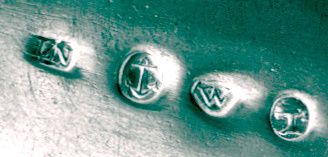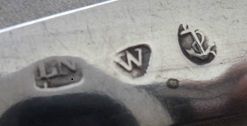Hi Grianaig,
Greenock marks do not have a fouled anchor otherwise you would be correct.
I never said it was Greenock, I just noted previous attributions to the closest sets of marks that I could find for you. But do not be inflexible as to some attributions, they are not written in stone. Greenock, for example, did not have a guild of hammermen and the town's coat of arms do not appear to contain an anchor. Several devices were used by the silversmiths in that town, including the 'Tree' mark, and the 'Ship in full sail' mark, as well as the 'Anchor' mark, there was nothing official about these marks and their choice and the way that the device was portrayed, as well as whatever else a smith decided to use, was entirely that of the silversmith himself. There is absolutely no reason to dismiss a fouled anchor as not of Greenock, only perhaps as unlikely to be of Greenock. Remember that that the punches used were made by the silversmiths themselves, or by by someone for them, and would be made to reflect the design of the silversmith's choosing, if they wanted to enhance a previously used local emblem, such as the anchor, by adding a theaded rope around it, there was nothing to stop them doing so.
As far as the above goes, I'm only using Greenock as an example, other provincial towns that did have their own guilds, were perhaps on a more formal footing as the use of certain symbols and devices. There is still a mountain of research to be done on Scottish provincial marking, and the towns that do not having surviving guild records will, no doubt, prove to be the most difficult.
So, always keep an open mind when researching unofficial marks, and never say never.
Trev.

